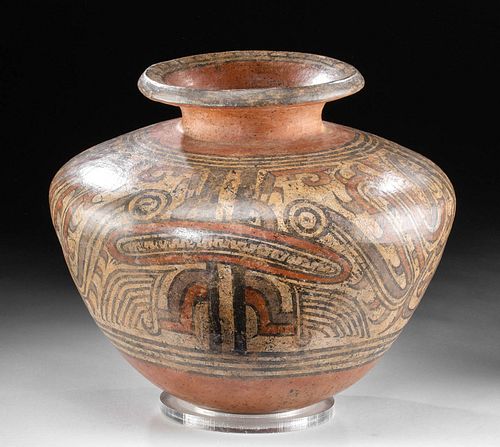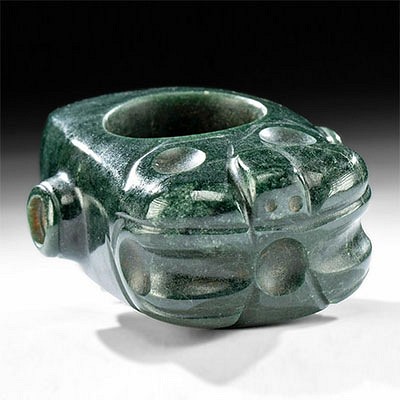Cocle Macaracas Polychrome Vessel w/ Saurian Motifs
Lot 116
About Seller
Artemis Fine Arts
686 S Taylor Ave, Ste 106
Louisville, CO 80027
United States
Selling antiquities, ancient and ethnographic art online since 1993, Artemis Gallery specializes in Classical Antiquities (Egyptian, Greek, Roman, Near Eastern), Asian, Pre-Columbian, African / Tribal / Oceanographic art. Our extensive inventory includes pottery, stone, metal, wood, glass and textil...Read more
Estimate:
$5,000 - $7,500
Absentee vs Live bid
Two ways to bid:
- Leave a max absentee bid and the platform will bid on your behalf up to your maximum bid during the live auction.
- Bid live during the auction and your bids will be submitted real-time to the auctioneer.
Bid Increments
| Price | Bid Increment |
|---|---|
| $0 | $25 |
| $300 | $50 |
| $1,000 | $100 |
| $2,000 | $250 |
| $5,000 | $500 |
| $10,000 | $1,000 |
| $20,000 | $2,500 |
| $50,000 | $5,000 |
| $100,000 | $10,000 |
| $200,000 | $20,000 |
About Auction
By Artemis Fine Arts
Sep 10, 2020
Set Reminder
2020-09-10 10:00:00
2020-09-10 10:00:00
America/New_York
Bidsquare
Bidsquare : Antiquities | Asian | Ethnographic Art
https://www.bidsquare.com/auctions/artemis-gallery/antiquities-asian-ethnographic-art-5546
Featuring classical antiquities, ancient and ethnographic art from cultures encompassing the globe. Egyptian, Greek, Roman, Etruscan, Near Eastern, Asian, Pre-Columbian, Native American, African / Tribal, Oceanic, Spanish Colonial, Russian, Fossils, Fine Art, more! Artemis Fine Arts info@artemisgallery.com
Featuring classical antiquities, ancient and ethnographic art from cultures encompassing the globe. Egyptian, Greek, Roman, Etruscan, Near Eastern, Asian, Pre-Columbian, Native American, African / Tribal, Oceanic, Spanish Colonial, Russian, Fossils, Fine Art, more! Artemis Fine Arts info@artemisgallery.com
- Lot Description
Pre-Columbian, Central America, Panama, Gran Cocle, Macaracas type, ca. 800 to 1000 CE. A gorgeous vessel of a sizable, round-bottomed form, hand-built from pottery and enveloped with applied pigment in hues of cream, black, vermilion, and amethyst. The inverted bell-shaped body has broad shoulders that taper to form the squat neck, and a thick rim flares off from the top. Displayed across the body are two identical panels depicting abstract reptilian creatures known as saurians with bullseye-form eyes, gaping mouths lined with fangs, long claws on the feet, and serrated tendrils that project from the sides of each saurian head and terminate in abstract serpentine heads. The extensive use of black, white, and red pigment is typical of fine Cocle artistry, and the addition of purple is characteristic of the Macaracas style. A wondrous example of Cocle artistic prowess! Lucite display stand for photography purposes only. Size: 11.3" W x 9.625" H (28.7 cm x 24.4 cm)
According to scholar Samuel Kirkland Lothrop, "The Gran Cocle culture is a Pre-Columbian archaeological culture that gets its name from the area from which it was based, the now present-day Cocle province of Panama. The Gran Cocle term applies to a loosely studied group of Native American sub-cultures in this region, identified by their pottery styles. The overall period spans a time from 150 B.C. to the end in the 16th century A.D. upon Spanish contact. The most ancient culture is the La Mula period from 150 B.C. to 300 A.D. The La Mula and later Monagrillo and Tonosí pottery styles are identified by their use of three paint colors which were black, red and white (or cream). The later Cubitá style saw the emergence of the use of four colors. The styles of Conte, Macaracas and Joaquín added purple to their palette and this hue ranged from grayish tones to red purple. The use of purple disappeared in the subsequent styles of Parita and El Altillo and the paint style reverted to the use of three colors. Most notable in the artistic renderings are the overt use of geometric designs." (For more information, see Armand Labbe, "Guardians of The Life Stream: Shamans, Art and Power in Prehispanic Central Panama" - Bowers Museum of Cultural Art, University of Washington Press, 1995)
For a strikingly similar example of the saurian motifs depicted on this example, please see: Labbe, Armand. "Guardians of The Life Stream: Shamans, Art and Power in Prehispanic Central Panama." Bowers Museum of Cultural Art, University of Washington Press, 1995, p. 16, fig. 4.
Provenance: ex-Barakat Gallery, Beverly Hills, California, USA, acquired prior to 2000
All items legal to buy/sell under U.S. Statute covering cultural patrimony Code 2600, CHAPTER 14, and are guaranteed to be as described or your money back.
A Certificate of Authenticity will accompany all winning bids.
We ship worldwide and handle all shipping in-house for your convenience.
#153771Abrasions and minor nicks to base, body, neck, and rim, with encrustations and minor calcifications, and light fading to areas of original pigment, otherwise intact and near-choice. Great earthen and mineral deposits as well as fabulous remains of original pigment throughout. Old inventory label beneath base.Condition
- Shipping Info
-
All shipping is handled in-house for your convenience. Your invoice from Artemis Gallery will include shipping calculation instructions. If in doubt, please inquire BEFORE bidding for estimated shipping costs for individual items.
-
- Buyer's Premium



 EUR
EUR CAD
CAD AUD
AUD GBP
GBP MXN
MXN HKD
HKD CNY
CNY MYR
MYR SEK
SEK SGD
SGD CHF
CHF THB
THB
















